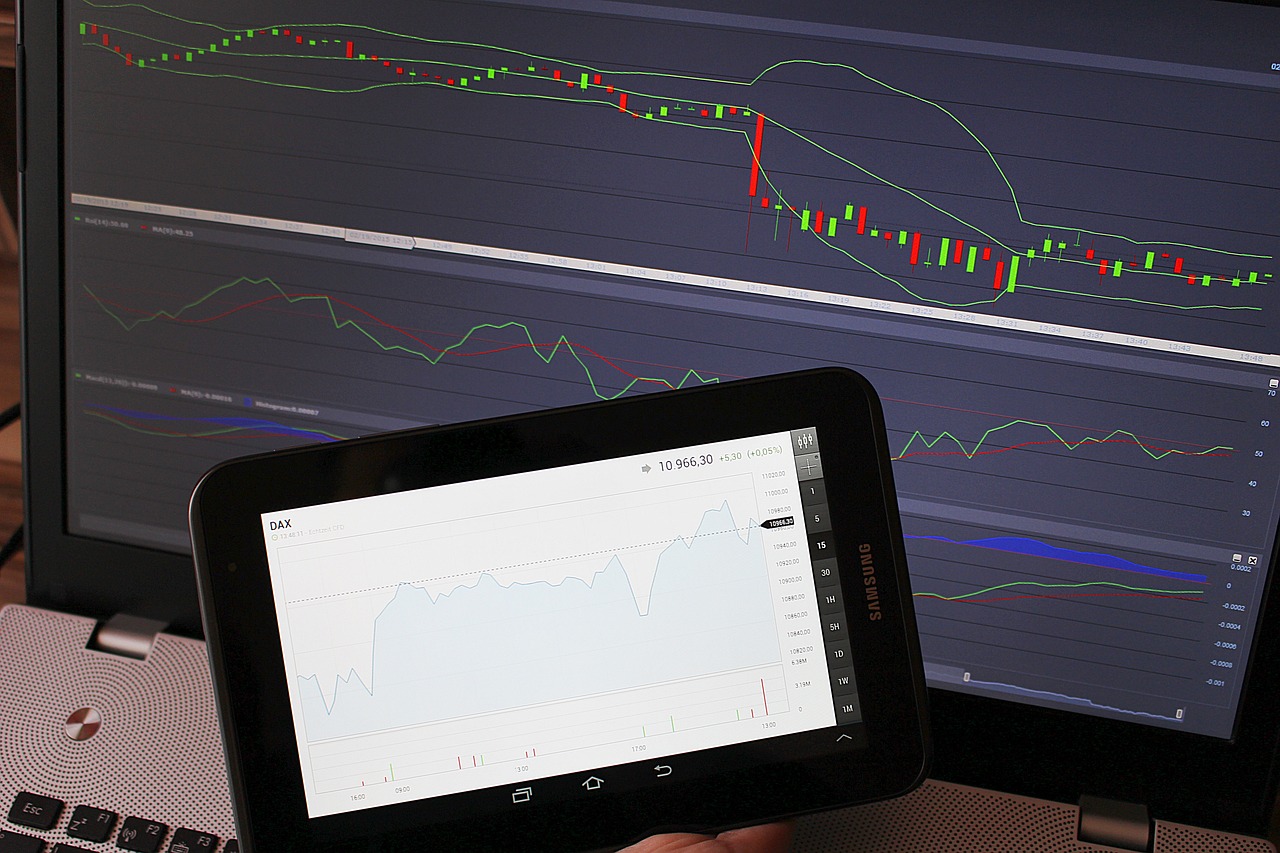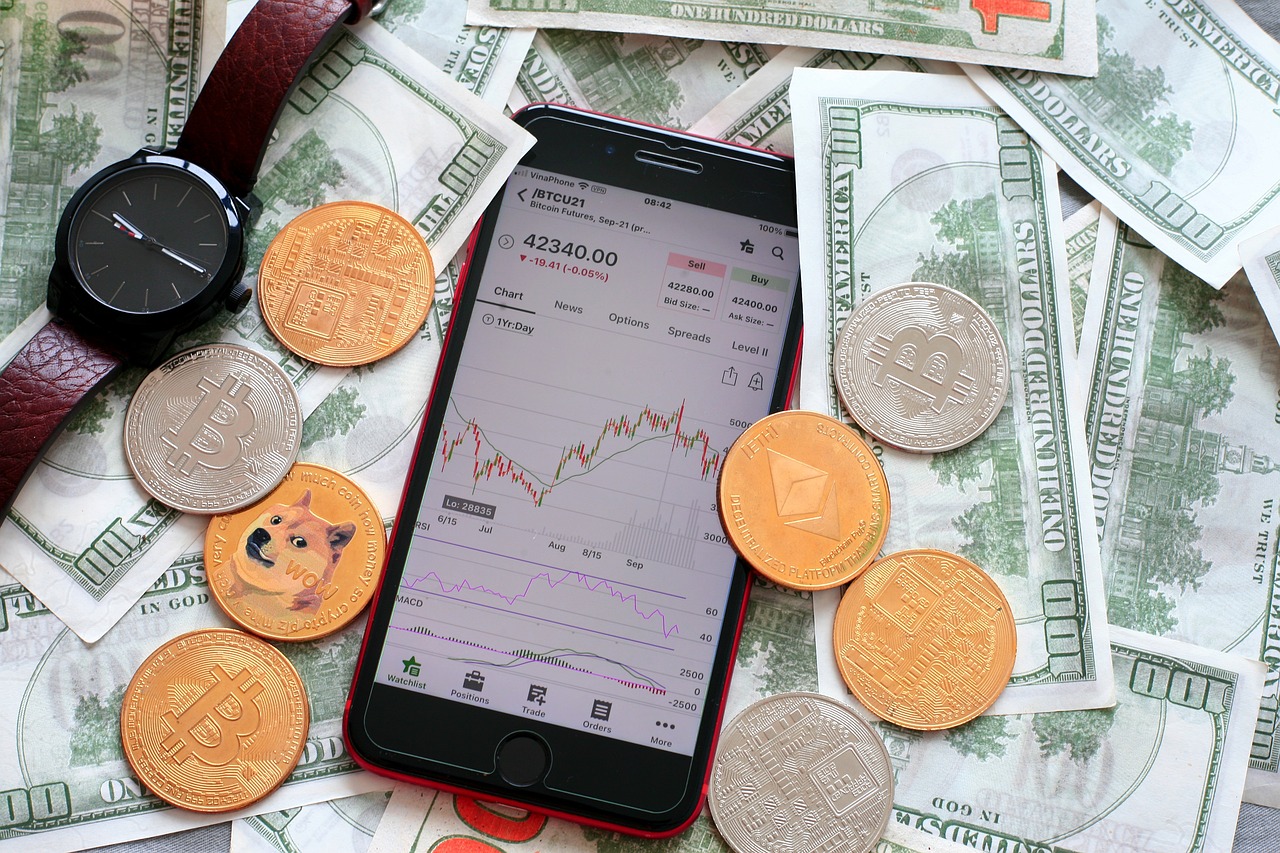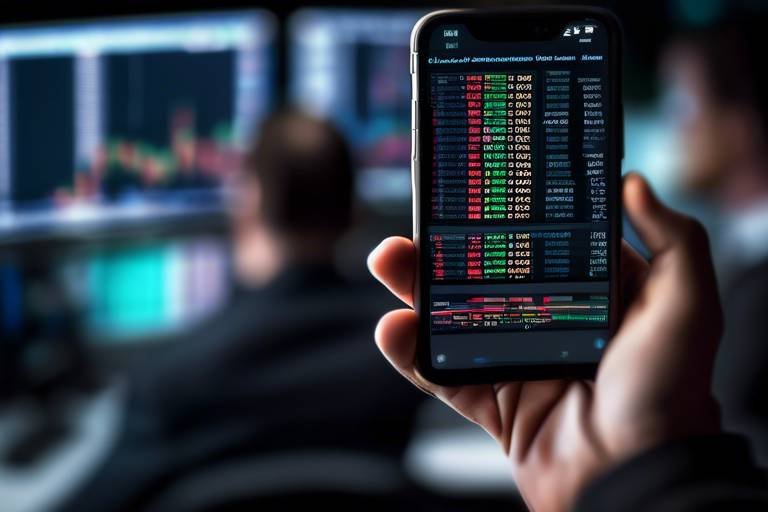How to Create a Winning Crypto Trading Strategy
In the fast-paced world of cryptocurrency trading, having a solid strategy is akin to having a roadmap in an unfamiliar city. Without it, you might find yourself lost, wandering through the volatile markets, and potentially making costly mistakes. So, how do you create a winning crypto trading strategy? It boils down to understanding a few essential components: market analysis, risk management, and the psychological factors that influence your trading decisions. By mastering these elements, you can navigate the crypto landscape with confidence and increase your chances of success.
Analyzing market trends is crucial for effective crypto trading. Think of market trends as the weather forecast for your trading journey. Just as you wouldn’t venture out in a storm without an umbrella, you shouldn't enter trades without understanding whether the market is bullish (rising) or bearish (falling). Identifying these trends can provide invaluable insights into potential price movements and help shape your trading strategies. For instance, when you spot a bullish trend, it might be an opportune moment to buy, while a bearish trend could signal the need to sell or short your positions.
Technical analysis tools are like the compass and map for traders, guiding them through the unpredictable terrain of the crypto market. These tools help traders make informed decisions based on historical price data and market behavior. Among the most popular tools are indicators and chart patterns, which are essential for predicting price movements. Understanding these tools can significantly enhance your trading prowess.
Chart patterns, such as head and shoulders or triangles, play a significant role in forecasting market behavior. Recognizing these patterns is like spotting a familiar landmark; they can signal potential reversals or continuations in price trends. For example, a head and shoulders pattern often indicates a reversal from a bullish to a bearish trend. By learning to identify and utilize these patterns, you can make more informed trading decisions and increase your chances of success.
Understanding support and resistance levels is vital for setting entry and exit points in your trades. Think of support levels as a safety net for prices, where they tend to bounce back up, while resistance levels act like a ceiling, preventing prices from rising further. By identifying these levels, you can strategically place your trades to maximize gains and minimize losses. For example, if a cryptocurrency has consistently bounced off a support level, it might be a good entry point for a buy order.
Moving averages are another powerful tool that smooth out price data to help identify trends over time. They act like a moving window, providing a clearer picture of where the market is headed. There are different types of moving averages, such as simple moving averages (SMA) and exponential moving averages (EMA), each serving a unique purpose in your trading strategy. For instance, EMAs give more weight to recent prices, making them more responsive to current market conditions. This can help you make quicker trading decisions based on the latest data.
Indicators and oscillators provide insights into market momentum and potential reversals. Popular tools like the Relative Strength Index (RSI) and the Moving Average Convergence Divergence (MACD) can be invaluable in your trading toolkit. The RSI, for example, measures the speed and change of price movements, helping you identify overbought or oversold conditions. On the other hand, the MACD can signal potential buy or sell opportunities based on the convergence and divergence of moving averages. By incorporating these tools into your strategy, you can enhance your market analysis and make more informed decisions.
Effective risk management is essential for long-term success in crypto trading. It's like wearing a seatbelt in a car; it may not prevent accidents, but it significantly reduces the risk of serious injury. By implementing sound risk management strategies, you can protect your capital and minimize losses, ensuring that you stay in the game even during turbulent market conditions.
Stop-loss orders are a trader's best friend when it comes to preventing significant losses. By automatically selling your assets at predetermined prices, stop-loss orders act as a safety net, allowing you to exit a trade before losses escalate. Setting effective stop-loss levels requires careful consideration of market volatility and your risk tolerance. For instance, placing a stop-loss just below a support level can help protect your investment while allowing for normal market fluctuations.
Diversification is another key strategy for spreading risk across different assets. Imagine you're at a buffet; instead of loading your plate with just one dish, you sample a variety to ensure a balanced meal. Similarly, creating a diversified crypto portfolio can help mitigate potential losses. By investing in a mix of cryptocurrencies with varying risk profiles, you can reduce the impact of a single asset's poor performance on your overall portfolio.
Understanding psychological factors is vital for maintaining discipline in trading. Emotions can be your worst enemy, often leading to impulsive decisions that can derail your trading strategy. Recognizing how emotions like fear and greed impact your decision-making is crucial for developing a sound trading mindset.
Fear and greed are common emotions that can lead to poor trading decisions. Fear might cause you to sell too early, while greed could tempt you to hold onto a position for too long. To overcome these feelings, it's important to establish clear trading rules and stick to them. For instance, setting specific profit targets and adhering to them can help curb the influence of greed, while employing stop-loss orders can alleviate fear.
Establishing a consistent trading routine can enhance focus and discipline. Think of it as training for a marathon; the more you practice, the better you become. By creating a structured approach to your trading activities, you can minimize emotional decision-making and improve your overall performance. This routine could include regular market analysis, reviewing your trades, and adjusting your strategy as needed.
- What is the best trading strategy for beginners? Beginners should focus on understanding market trends and practicing risk management before diving into complex strategies.
- How can I manage my emotions while trading? Developing a trading routine and setting clear rules can help you stay disciplined and reduce the influence of emotions.
- What is the importance of diversification in crypto trading? Diversification helps spread risk across different assets, reducing the impact of a single asset's poor performance on your overall portfolio.

Understanding Market Trends
When diving into the world of crypto trading, understanding market trends is as crucial as knowing the back of your hand. Why? Because trends are like the currents in a river; they can either carry you to success or sweep you away into turbulent waters. Identifying whether the market is in a bullish (upward) or bearish (downward) phase can significantly influence your trading strategy. But how do you spot these trends? Let's break it down!
First off, a bullish trend is characterized by rising prices, often driven by increased demand and positive market sentiment. Picture a party where everyone is excited and buying drinks; the more people buy, the higher the prices go. On the flip side, a bearish trend occurs when prices are falling, often due to negative news or market sentiment. It's like a party where everyone is leaving and the drinks are being discounted – the more people exit, the lower the prices drop.
To effectively analyze these trends, traders often employ a mix of fundamental and technical analysis. Fundamental analysis involves looking at the underlying factors affecting a cryptocurrency's value, such as technological advancements, regulatory news, or market demand. Meanwhile, technical analysis focuses on historical price movements and trading volumes to predict future trends. Here’s a quick look at some key indicators:
| Indicator | Description |
|---|---|
| Moving Averages | Smooth out price data to identify trends over time. |
| Relative Strength Index (RSI) | Measures the speed and change of price movements to identify overbought or oversold conditions. |
| MACD (Moving Average Convergence Divergence) | Shows the relationship between two moving averages of a security’s price. |
Recognizing these trends can help you make informed trading decisions. For instance, in a bullish market, you might want to consider entering trades that capitalize on upward momentum, while in a bearish market, short-selling could be a viable strategy. However, it's not just about recognizing the trend; understanding its implications is equally important. For example, a sudden shift from bullish to bearish can catch even seasoned traders off guard, leading to hasty decisions and potential losses.
Moreover, it’s essential to stay updated with market news and events that can influence trends. The crypto market is notoriously volatile and can change direction in the blink of an eye. Therefore, keeping an eye on news sources, social media, and market sentiment can provide valuable insights into potential trend shifts.
In summary, mastering the art of understanding market trends is a vital piece of the crypto trading puzzle. By recognizing bullish and bearish phases and employing the right analysis tools, you can navigate the complex waters of cryptocurrency trading with confidence. Remember, the key is to stay informed and adaptable, ensuring that you can ride the waves of change rather than be swept away by them.

Technical Analysis Tools
When it comes to navigating the volatile waters of crypto trading, are your compass and map rolled into one. These tools help traders make informed decisions by analyzing price movements and market trends. Imagine trying to find your way in a dense forest without a map; that’s what trading is like without these essential tools. They provide insights that can guide your trading strategy and enhance your chances of success.
One of the most popular forms of technical analysis involves examining chart patterns. These patterns, such as head and shoulders, triangles, and flags, can signal potential price movements. For instance, a head and shoulders pattern often indicates a reversal in trend, suggesting that it might be time to sell. Recognizing these patterns can give traders a significant edge, as they can anticipate market behavior before it unfolds.
Chart patterns are visual representations of price movements that traders use to predict future actions. They are like the footprints left behind by traders before you, providing clues about where the market might head next. Some common patterns include:
- Head and Shoulders: Often signals a reversal from bullish to bearish.
- Triangles: Can indicate continuation or reversal, depending on the breakout direction.
- Flags and Pennants: Typically signal a continuation of the current trend.
Understanding these patterns allows traders to make more educated decisions about when to enter or exit trades. For example, if you spot a head and shoulders pattern forming, you might consider it a red flag and prepare to sell your assets before the price starts to decline.
Another critical aspect of technical analysis is understanding support and resistance levels. Think of support levels as the floor that prevents prices from falling further, while resistance levels act like a ceiling that prices struggle to break through. Identifying these levels can significantly influence your trading strategy. For instance, if the price approaches a strong support level, it may be a good opportunity to buy, anticipating a bounce back. Conversely, if it reaches a resistance level, it might be wise to sell or set a stop-loss order to protect your capital.
Moving averages are another vital tool in a trader's arsenal. They help smooth out price data to identify trends over time, making them easier to interpret. There are several types of moving averages, including:
- SMA (Simple Moving Average): The average price over a specific period.
- EMA (Exponential Moving Average): Gives more weight to recent prices, making it more responsive to new information.
Traders often use moving averages to determine entry and exit points. For example, if a short-term moving average crosses above a long-term moving average, it could signal a bullish trend, prompting traders to buy. On the flip side, a cross below might indicate a bearish trend, suggesting it’s time to sell.
Indicators and oscillators provide additional insights into market momentum and potential reversals. Tools like the Relative Strength Index (RSI) and Moving Average Convergence Divergence (MACD) are widely used among traders. The RSI helps determine whether an asset is overbought or oversold, while the MACD can indicate changes in momentum. Using these tools in conjunction with chart patterns and moving averages can create a robust trading strategy that adapts to market changes.
In conclusion, mastering technical analysis tools is akin to learning the rules of a game before playing it. The more you understand and utilize these tools, the better equipped you will be to navigate the unpredictable world of crypto trading. So, take the time to familiarize yourself with chart patterns, support and resistance levels, moving averages, and various indicators. Your trading strategy will thank you!
Q: What are the best technical analysis tools for beginners?
A: For beginners, starting with simple tools like moving averages and RSI can be beneficial. These tools are user-friendly and provide essential insights into market trends.
Q: How can I improve my skills in technical analysis?
A: Practice is key! Use demo accounts to apply what you learn without risking real money. Additionally, consider following experienced traders and studying their strategies.
Q: Is technical analysis effective for all cryptocurrencies?
A: While technical analysis can be applied to any cryptocurrency, its effectiveness may vary based on the asset's volatility and market behavior. Always conduct thorough research and combine analysis methods for the best results.

Chart Patterns
Chart patterns are the backbone of technical analysis in crypto trading. They provide traders with visual cues about potential market behavior, helping to forecast future price movements. Imagine walking into a crowded room and instantly spotting your friends based on their unique outfits; that's what recognizing chart patterns is like for traders. By identifying these formations, traders can make informed decisions about when to enter or exit a position.
Some of the most popular chart patterns include the head and shoulders, double tops and bottoms, and triangles. Each of these patterns has its own significance and implications for trading strategies. For instance, a head and shoulders pattern often signals a reversal in trend, indicating that a bullish market may soon turn bearish. On the other hand, a triangle pattern can suggest a continuation of the current trend, whether bullish or bearish, depending on the breakout direction.
To effectively utilize these patterns, traders must not only recognize them but also understand their context within the broader market landscape. This means looking at volume, market sentiment, and other technical indicators to confirm the signals provided by the patterns. For example, a breakout from a triangle pattern accompanied by high trading volume is often seen as a more reliable signal than one with low volume. This is where the synergy of various technical analysis tools comes into play, painting a clearer picture of market dynamics.
Here’s a brief overview of some common chart patterns:
| Pattern | Type | Implication |
|---|---|---|
| Head and Shoulders | Reversal | Bearish signal after an uptrend |
| Double Top | Reversal | Bearish signal after an uptrend |
| Double Bottom | Reversal | Bullish signal after a downtrend |
| Triangles (Ascending/Descending) | Continuation | Indicates potential breakout direction |
Recognizing these patterns can be a game-changer in your trading strategy. However, it's essential to remember that no pattern is foolproof. Market conditions can change rapidly, and external factors can influence price movements in unexpected ways. Therefore, combining chart patterns with other analysis techniques, such as indicators and oscillators, can enhance your trading strategy's effectiveness.
In conclusion, mastering chart patterns is a crucial step for any trader looking to navigate the volatile waters of the crypto market. By developing a keen eye for these formations and understanding their implications, you can significantly improve your chances of making profitable trades. Just like a skilled detective piecing together clues, you too can uncover the secrets hidden in the charts.
- What are chart patterns? Chart patterns are visual formations on a price chart that can indicate potential future price movements.
- How reliable are chart patterns? While chart patterns can provide valuable insights, they are not foolproof and should be used in conjunction with other analysis techniques.
- Can I trade based solely on chart patterns? It's advisable to combine chart patterns with other tools, such as indicators and market analysis, for a more comprehensive trading strategy.

Support and Resistance Levels
Support and resistance levels are essential concepts in technical analysis that help traders make informed decisions. Think of support as the floor of a room; it’s where prices tend to stop falling and often bounce back up. Conversely, resistance acts like a ceiling, where prices tend to halt their rise and often reverse direction. Understanding these levels can significantly enhance your trading strategy, allowing you to set more precise entry and exit points.
Identifying support and resistance levels involves analyzing historical price data. Traders often look for points where the price has repeatedly bounced off a level (support) or faced rejection (resistance). These levels are not always exact; they can act as zones where prices fluctuate. For instance, if a cryptocurrency has consistently bounced back at $30,000, this price becomes a psychological barrier for traders, making it a critical support level. Conversely, if prices have struggled to break above $35,000, this price can be viewed as a resistance level.
One effective way to visualize these levels is by using a simple table that summarizes key support and resistance points for a specific cryptocurrency:
| Cryptocurrency | Support Level | Resistance Level |
|---|---|---|
| Bitcoin (BTC) | $30,000 | $35,000 |
| Ethereum (ETH) | $1,800 | $2,200 |
| Ripple (XRP) | $0.50 | $0.75 |
Traders often combine support and resistance levels with other technical indicators to confirm their strategies. For example, if a trader sees that the price is approaching the support level of $30,000 while the Relative Strength Index (RSI) indicates that the asset is oversold, it might signal a good buying opportunity. On the other hand, if the price nears the resistance level of $35,000 and the RSI shows overbought conditions, it could be a signal to sell or short the asset.
In summary, understanding support and resistance levels is crucial for any trader looking to navigate the volatile crypto market. These levels provide a framework for making strategic decisions, allowing you to optimize your trading plan and potentially increase your profitability. Remember, the key to success in trading often lies in recognizing these patterns and using them to your advantage.

Moving Averages
When it comes to navigating the tumultuous waters of the crypto market, serve as a beacon guiding traders through the fog. These powerful tools help smooth out price data, allowing you to identify trends over time without getting bogged down by the day-to-day fluctuations that can drive you crazy. Think of moving averages as your trusty compass, showing you the general direction of the market while filtering out the noise.
There are several types of moving averages, each with its own unique characteristics and applications. The most common types are the Simple Moving Average (SMA) and the Exponential Moving Average (EMA). The SMA is calculated by taking the average of a set number of closing prices over a specific period, while the EMA gives more weight to recent prices, making it more responsive to new information. This responsiveness can be crucial in a market that changes as rapidly as cryptocurrency.
| Type of Moving Average | Calculation Method | Best Used For |
|---|---|---|
| Simple Moving Average (SMA) | Average of closing prices over a specified period | Identifying overall trends |
| Exponential Moving Average (EMA) | More weight on recent prices | Spotting quick changes in momentum |
Now, how do you use these moving averages in your trading strategy? One popular approach is to look for crossover signals. This occurs when a shorter-term moving average crosses above or below a longer-term moving average. For instance, if the 50-day EMA crosses above the 200-day EMA, it’s often seen as a bullish signal, suggesting that it might be time to buy. Conversely, if the 50-day EMA crosses below the 200-day EMA, it could indicate a bearish trend, signaling a potential sell-off.
Another important aspect to consider is the period length you choose for your moving averages. Shorter periods, like the 10-day or 20-day, are great for capturing short-term trends, while longer periods, such as the 100-day or 200-day, can help you identify long-term trends. The key is to find a balance that suits your trading style and risk tolerance.
However, while moving averages can provide valuable insights, they are not foolproof. They lag behind the price action since they are based on historical data. This means that by the time a signal is generated, the price may have already moved significantly. Therefore, it’s essential to use them in conjunction with other technical analysis tools and indicators to form a more comprehensive trading strategy.
In summary, moving averages are an indispensable tool in a trader's arsenal. They help you cut through the chaos of the crypto market, providing clarity and direction. By understanding the different types of moving averages and how to apply them effectively, you can enhance your trading strategy and make more informed decisions. Remember, in the world of crypto trading, knowledge is power, and moving averages can be your guiding light.
- What is the primary purpose of moving averages in trading?
Moving averages help traders identify trends by smoothing out price data and reducing noise, making it easier to spot potential buy or sell signals. - How do I choose the right period for moving averages?
The choice of period depends on your trading strategy; shorter periods are better for short-term trading, while longer periods are suited for long-term analysis. - Can moving averages be used for all cryptocurrencies?
Yes, moving averages can be applied to any cryptocurrency, but the effectiveness may vary based on market conditions and the specific asset's volatility.

Indicators and Oscillators
In the dynamic world of cryptocurrency trading, indicators and oscillators serve as invaluable tools that help traders decipher the complex movements of the market. These tools allow traders to gain insights into market momentum and potential price reversals, providing a clearer picture of when to enter or exit trades. But what exactly are these indicators, and how can they be effectively utilized in your trading strategy?
At their core, indicators are mathematical calculations based on the price, volume, or open interest of a security. They can be categorized into two main types: leading and lagging indicators. Leading indicators, such as the Relative Strength Index (RSI), are designed to predict future price movements, while lagging indicators, like the Moving Average Convergence Divergence (MACD), provide insights based on past price movements. Understanding the distinction between these two types is crucial for developing a well-rounded trading strategy.
For instance, the RSI is a momentum oscillator that measures the speed and change of price movements. It ranges from 0 to 100 and is typically used to identify overbought or oversold conditions in a market. A reading above 70 may indicate that an asset is overbought, suggesting a potential price correction, while a reading below 30 may signal that an asset is oversold and could be due for a rebound. This can help traders make informed decisions about when to buy or sell.
On the other hand, the MACD is a trend-following momentum indicator that shows the relationship between two moving averages of a security’s price. The MACD is calculated by subtracting the 26-period exponential moving average (EMA) from the 12-period EMA. When the MACD crosses above the signal line (the 9-day EMA of the MACD), it can be interpreted as a bullish signal, while a cross below the signal line can indicate a bearish trend. This duality of indicators allows traders to confirm trends and refine their entries and exits.
Moreover, it’s essential to understand that while indicators and oscillators are powerful, they are not foolproof. Relying solely on them without considering other factors—like market news, fundamental analysis, or even personal trading psychology—can lead to poor decision-making. Therefore, integrating these tools into a broader trading strategy is vital.
To illustrate the effectiveness of these tools, let’s take a look at a simple comparison of some popular indicators:
| Indicator | Type | Purpose |
|---|---|---|
| Relative Strength Index (RSI) | Leading | Identifies overbought/oversold conditions |
| Moving Average Convergence Divergence (MACD) | Lagging | Confirms trends and potential reversals |
| Bollinger Bands | Lagging | Measures market volatility and price levels |
| Stochastic Oscillator | Leading | Compares a security's closing price to its price range over a specific period |
In conclusion, incorporating indicators and oscillators into your trading toolkit can significantly enhance your ability to make informed decisions in the crypto market. However, it's essential to remain vigilant and combine these tools with thorough market analysis and sound risk management practices. By doing so, you can navigate the volatile waters of cryptocurrency trading with greater confidence and precision.
- What are indicators and oscillators?
Indicators are mathematical calculations based on market data used to predict price movements, while oscillators are a type of indicator that fluctuates within a range to indicate momentum or trend strength. - How can I use RSI in my trading?
The RSI can help you identify overbought or oversold conditions, guiding your buy or sell decisions based on its readings above 70 or below 30. - What is the best indicator for beginners?
Many beginners find the Moving Average to be a straightforward and effective tool for identifying trends, while the RSI offers insights into market momentum.

Risk Management Strategies
When it comes to crypto trading, the thrill of potential profits can be intoxicating. However, without a solid risk management strategy, that thrill can quickly turn into a nightmare. Think of risk management as your safety net; it’s what keeps you from falling into the abyss of significant financial losses. So, how do you create an effective risk management strategy? Let’s dive into the essentials that every trader should consider.
First and foremost, you need to understand that not all trades will be winners. It’s crucial to accept that losses are part of the game. By acknowledging this reality, you can better prepare yourself to handle the emotional rollercoaster that comes with trading. One effective way to manage risk is by setting stop-loss orders. These orders automatically sell your assets when they reach a predetermined price, effectively capping your losses. Imagine you’re on a rollercoaster, and you’ve got a safety harness; that’s what stop-loss orders do for your investments.
To set effective stop-loss levels, consider the volatility of the asset you’re trading. For instance, a highly volatile cryptocurrency might require a wider stop-loss to avoid being triggered by normal price fluctuations. Conversely, a more stable asset might benefit from a tighter stop-loss. A good rule of thumb is to set your stop-loss at a level where you can still maintain your trading strategy without letting emotions dictate your actions. Here’s a simple table to illustrate how different assets might require varying stop-loss strategies:
| Asset Type | Volatility Level | Recommended Stop-Loss (%) |
|---|---|---|
| High Volatility | Very Volatile | 10-15% |
| Medium Volatility | Moderately Volatile | 5-10% |
| Low Volatility | Stable | 2-5% |
Another cornerstone of risk management is diversification. Just like you wouldn’t put all your eggs in one basket, you shouldn’t concentrate your investments in a single cryptocurrency. By spreading your investments across a variety of assets, you can mitigate potential losses. For example, if one asset takes a nosedive, your other investments might still perform well, helping to cushion the blow. Here are some tips for creating a diversified crypto portfolio:
- Invest in different sectors of the crypto market, such as DeFi, NFTs, and stablecoins.
- Consider geographic diversification by investing in cryptocurrencies that are popular in different regions.
- Allocate a portion of your portfolio to established coins like Bitcoin and Ethereum, while also exploring emerging altcoins.
Lastly, remember that risk management is not a one-time task but an ongoing process. Regularly review and adjust your strategies based on market conditions and your own financial goals. This adaptability is crucial in a market as dynamic as cryptocurrency. By being proactive and continuously assessing your risk exposure, you can navigate the volatile waters of crypto trading with greater confidence.

Setting Stop-Loss Orders
When it comes to trading cryptocurrencies, one of the most crucial tools in your arsenal is the stop-loss order. This nifty feature acts like a safety net, designed to protect your investment from significant downturns. Imagine you're sailing on a beautiful day, and suddenly, a storm brews on the horizon. A stop-loss order is like your life jacket—essential for keeping you afloat when the waves get rough!
So, how does it work? Essentially, a stop-loss order allows you to set a predetermined price at which your asset will automatically sell if the market takes a nosedive. This means you can limit your losses without having to constantly monitor the market. For instance, if you buy Bitcoin at $50,000 and set a stop-loss at $48,000, your asset will sell automatically if the price drops to that level, helping you avoid further losses.
But wait, there’s more! Setting effective stop-loss levels isn’t just about slapping a number on your trades. You need to consider several factors:
- Market Volatility: Cryptocurrencies are notoriously volatile. A good rule of thumb is to set your stop-loss slightly below a support level or a recent low to give your trade some breathing room.
- Risk Tolerance: Everyone has a different appetite for risk. Define how much you are willing to lose on a trade and set your stop-loss accordingly.
- Trading Strategy: Your overall trading strategy should dictate your stop-loss placement. Are you a day trader looking for quick profits, or are you in it for the long haul? Your approach will influence where you set your stop-loss.
Additionally, you can choose between two main types of stop-loss orders: fixed stop-loss and trailing stop-loss. A fixed stop-loss is set at a specific price point, while a trailing stop-loss moves with the market price, allowing you to lock in profits as the price rises. This flexibility can be a game-changer, especially in a market as dynamic as crypto!
Here’s a quick comparison:
| Type | Description | Best For |
|---|---|---|
| Fixed Stop-Loss | Sells at a predetermined price | Conservative traders |
| Trailing Stop-Loss | Moves with market price | Traders looking to maximize profits |
Remember, the goal of a stop-loss order is not just to prevent losses but to provide you with peace of mind. By automating your exit strategy, you can focus on the bigger picture and avoid emotional decision-making that often leads to regrettable trades. So, take the time to set your stop-loss orders wisely, and you’ll find that they can significantly enhance your trading strategy!
Q: What is a stop-loss order?
A stop-loss order is a predetermined price at which a trader's asset will automatically sell to prevent further losses.
Q: How do I set a stop-loss order?
To set a stop-loss order, you need to determine the price point at which you want to sell your asset if the market moves against you.
Q: Can I change my stop-loss order once it's set?
Yes, you can adjust your stop-loss order at any time, depending on market conditions and your trading strategy.

Diversification Techniques
Diversification is like creating a safety net for your crypto investments. Imagine you're at a carnival, and you decide to try out several games instead of just one. If one game doesn’t go well, you still have others to fall back on. In the world of crypto trading, this means spreading your investments across various cryptocurrencies instead of putting all your eggs in one digital basket. By doing so, you can significantly reduce the risk of a major loss if one particular asset plummets.
When it comes to diversifying your crypto portfolio, it’s essential to consider several factors. First, think about the different categories of cryptocurrencies available. You have large-cap coins like Bitcoin and Ethereum, which are generally more stable, and small-cap coins that can offer higher potential returns but come with increased risk. A well-balanced portfolio might include:
| Category | Examples | Risk Level |
|---|---|---|
| Large-Cap Coins | Bitcoin, Ethereum | Low |
| Mid-Cap Coins | Cardano, Polkadot | Medium |
| Small-Cap Coins | Shiba Inu, Dogecoin | High |
Moreover, consider diversifying across different sectors within the crypto space. Just like investing in various industries in the stock market, you can explore areas such as DeFi (Decentralized Finance), NFTs (Non-Fungible Tokens), and blockchain infrastructure. By investing in a mix of these sectors, you can enhance your chances of capitalizing on emerging trends while cushioning your portfolio from sector-specific downturns.
Another vital aspect of diversification is the geographical distribution of your investments. Cryptocurrencies are not limited to one region; they are global. Therefore, consider investing in projects from different countries. This not only spreads your risk but also allows you to tap into various markets that may perform differently based on local regulations and economic conditions.
Lastly, remember that diversification isn’t a one-time task; it’s an ongoing process. As the market evolves, so should your strategy. Regularly review your portfolio and adjust your holdings based on performance and market trends. This proactive approach ensures that you stay ahead of the curve and can adapt to the ever-changing landscape of the crypto world.
In summary, diversification techniques in crypto trading are essential for managing risk and maximizing potential returns. By spreading your investments across different cryptocurrencies, sectors, and regions, you create a more resilient portfolio that can weather the market's ups and downs. So, before jumping into the next big crypto opportunity, take a moment to evaluate how you can diversify effectively and safeguard your investments.
- What is diversification in crypto trading? Diversification involves spreading your investments across various cryptocurrencies to reduce risk and enhance potential returns.
- Why is diversification important? It helps mitigate losses from underperforming assets and allows you to benefit from the growth of others.
- How many cryptocurrencies should I invest in? It varies based on your risk tolerance, but a mix of large-cap, mid-cap, and small-cap coins is generally recommended.
- Can I diversify without investing in many coins? Yes, you can also diversify by investing in different sectors, such as DeFi and NFTs, or by using crypto index funds.

Psychological Factors in Trading
When it comes to trading, especially in the volatile world of cryptocurrencies, psychological factors play an enormous role in shaping a trader's success. You might have the best trading strategy in place, but if your mind isn't in the right place, it can all go out the window in a heartbeat. Think of trading like riding a roller coaster; it’s thrilling, but if you let fear or excitement take the wheel, you might just end up screaming for all the wrong reasons!
One of the most significant psychological hurdles traders face is the emotional battle between fear and greed. Fear can paralyze you, making you hesitate to enter a trade or causing you to exit too early. On the flip side, greed can lead to reckless decisions, like holding onto a coin for too long, hoping for that one last spike. This push and pull can create a chaotic trading experience, where logic takes a backseat to emotion.
To navigate these psychological challenges, it’s essential to develop a strong self-awareness of your emotional triggers. Ask yourself: What makes me anxious about a trade? Is it the fear of missing out (FOMO) or the dread of losing money? Understanding these feelings can help you create a mental framework for decision-making. Here are some tips to manage these emotions:
- Recognize Your Triggers: Keep a trading journal where you note your feelings before, during, and after trades. This can help you identify patterns in your emotional responses.
- Practice Mindfulness: Techniques like meditation or deep-breathing exercises can help calm your mind and reduce impulsive decisions.
- Set Clear Goals: Establish specific, measurable goals for your trading activities. This clarity can help you stay focused and prevent emotional trading.
Another crucial aspect of trading psychology is the importance of having a trading routine. Just like an athlete prepares for a big game with a warm-up routine, you too should establish a consistent approach to your trading activities. A routine can include analyzing market trends, reviewing your previous trades, and setting your trading goals for the day. This structure not only helps keep emotions in check but also enhances your overall focus and discipline.
Moreover, it’s essential to embrace the idea that losses are part of the game. Every trader experiences losses; it’s how you respond to them that counts. Instead of viewing losses as failures, consider them as valuable lessons that contribute to your growth as a trader. This shift in mindset can significantly reduce the emotional burden associated with trading.
In summary, mastering the psychological factors in trading is just as important as understanding market trends and technical analysis. By recognizing and managing your emotions, establishing a structured routine, and viewing losses as learning opportunities, you can enhance your trading performance and pave the way for long-term success in the crypto market.
Q: How can I manage my emotions while trading?
A: Keeping a trading journal, practicing mindfulness, and setting clear goals can help you manage your emotions effectively.
Q: What should I do if I experience a significant loss?
A: Instead of viewing it as a failure, analyze what went wrong and treat it as a learning opportunity to improve your future trades.
Q: Why is a trading routine important?
A: A trading routine provides structure, enhances focus, and helps reduce emotional decision-making, leading to more consistent trading performance.

Overcoming Fear and Greed
Trading in the crypto market can often feel like a rollercoaster ride, filled with thrilling highs and nerve-wracking lows. One moment, you might feel on top of the world, and the next, you could be gripped by a paralyzing fear of loss. Fear and greed are two powerful emotions that can lead to impulsive decisions and ultimately derail your trading strategy. So how do you overcome these feelings and maintain a steady hand in the volatile world of cryptocurrencies?
First and foremost, it’s crucial to recognize when these emotions are influencing your decisions. Fear often manifests as hesitation or second-guessing your trades, while greed can lead to overtrading or holding onto assets for too long in hopes of further gains. Acknowledging these feelings is the first step toward managing them effectively. Think of it like a storm brewing on the horizon; if you can see it coming, you can prepare your ship to weather it.
One effective way to combat fear and greed is by establishing a set of rules and guidelines for your trading activities. These rules should include specific entry and exit points, as well as predetermined stop-loss levels. By having a clear plan in place, you can minimize emotional trading. Here’s a quick look at what your trading rules might include:
- Entry Points: Define the conditions under which you will buy a cryptocurrency.
- Exit Points: Clearly outline when you will sell your assets, whether for profit or to cut losses.
- Stop-Loss Orders: Set automatic sell orders to limit potential losses.
Another powerful technique is to practice mindfulness and self-reflection. Taking a moment to breathe and assess your feelings before making a trade can significantly reduce impulsive decisions driven by fear or greed. Consider keeping a trading journal where you document your trades, the emotions you felt during each decision, and the outcomes. This practice not only helps you learn from past mistakes but also creates a clearer picture of your emotional triggers.
Furthermore, surrounding yourself with a supportive community can also help in overcoming these emotional hurdles. Engaging with fellow traders, whether through online forums or local meetups, allows you to share experiences and strategies. It’s like having a safety net; when you know others are in the same boat, it’s easier to navigate the choppy waters of trading.
Lastly, remember that trading is not just about making profits; it’s also about managing risks and learning from every experience. Embrace the journey, and don’t let fear and greed dictate your actions. By implementing these strategies, you can cultivate a disciplined approach to trading that keeps your emotions in check and your focus on long-term success.
What is the biggest challenge in overcoming fear and greed in trading?
The biggest challenge is often recognizing when these emotions are influencing your decisions. It requires self-awareness and discipline to stick to your trading plan despite emotional pressures.
How can I develop a trading plan?
Start by defining your trading goals, risk tolerance, and the strategies you want to implement. Include clear entry and exit points, as well as stop-loss levels to protect your capital.
Is it normal to feel fear and greed while trading?
Absolutely! These emotions are natural responses to the high-stakes environment of trading. The key is to learn how to manage them effectively.
Can a trading journal really help?
Yes, maintaining a trading journal allows you to reflect on your decisions, recognize emotional triggers, and learn from past trades, ultimately improving your trading strategy.

Developing a Trading Routine
Creating a trading routine is like laying the foundation of a house; without it, everything else can crumble. A well-defined routine helps you stay focused, disciplined, and ultimately, successful in your trading endeavors. Think about it: when you wake up in the morning, do you dive straight into trading without a plan? Or do you have a structured approach that sets the tone for your day? Developing a trading routine means establishing a series of steps that you consistently follow, ensuring that you make informed decisions rather than emotional ones.
First things first, start your day with a market overview. This could be as simple as checking the latest news, analyzing price movements, and reviewing your previous trades. By doing this, you’re not just jumping into the market blindly; you’re arming yourself with the knowledge needed to make informed decisions. You might want to ask yourself questions like: What are the current trends? Are there any upcoming events that could impact the market? This initial assessment can significantly shape your trading strategy for the day.
Next, consider setting specific trading hours. Just like a regular job, having designated trading times can help you maintain discipline and prevent burnout. It’s essential to know when you’re most alert and responsive. Some traders thrive in the early hours, while others might find their groove later in the day. Whatever your preference, stick to it. This consistency will help you develop a rhythm and make your trading more effective.
In addition to your trading hours, it’s crucial to incorporate review sessions into your routine. After trading, take some time to analyze your performance. What worked? What didn’t? This reflection is vital for growth. You can even maintain a trading journal where you note down your thoughts, strategies, and outcomes. Over time, this journal will become an invaluable resource, helping you identify patterns in your trading behavior.
Finally, don't forget to include a self-care routine in your trading schedule. Trading can be stressful, and neglecting your mental and physical health can lead to poor decision-making. Make time for activities that help you unwind, whether that’s exercising, meditating, or simply spending time with loved ones. Remember, a clear mind is a trader's best asset!
In summary, developing a trading routine is not just about the mechanics of trading; it’s about fostering a mindset that promotes success. By establishing a structured approach, you can navigate the complexities of the crypto market with confidence and clarity. So, what are you waiting for? Start crafting your trading routine today!
- What should I include in my trading routine? Your routine should include market analysis, trading hours, review sessions, and self-care activities.
- How often should I review my trading performance? Regular reviews, ideally at the end of each trading day, can help you identify strengths and weaknesses.
- Can a trading routine really improve my performance? Yes! A structured routine helps maintain discipline and reduces emotional trading.
Frequently Asked Questions
- What is a crypto trading strategy?
A crypto trading strategy is a plan that outlines how a trader intends to buy and sell cryptocurrencies in order to achieve their financial goals. It includes components such as market analysis, risk management, and psychological factors that influence trading decisions.
- How do I identify market trends?
Identifying market trends involves analyzing price movements and patterns over time. Traders typically look for bullish (upward) or bearish (downward) trends by examining charts and using technical analysis tools to spot key indicators of market direction.
- What are technical analysis tools?
Technical analysis tools are instruments that help traders evaluate cryptocurrencies by analyzing statistical trends from trading activity, such as price movement and volume. Common tools include chart patterns, moving averages, and indicators like RSI and MACD.
- What are support and resistance levels?
Support and resistance levels are price points on a chart where the price tends to stop and reverse. Support is where the price tends to find buying interest, while resistance is where selling interest typically emerges. Understanding these levels can help traders set effective entry and exit points.
- How can I manage risk in crypto trading?
Managing risk in crypto trading can be achieved through several strategies, such as setting stop-loss orders to limit potential losses, diversifying your portfolio to spread risk across different assets, and only investing what you can afford to lose.
- What is a stop-loss order?
A stop-loss order is a predetermined price point at which a trader will sell an asset to prevent further losses. Setting effective stop-loss levels can help protect your capital in volatile markets.
- How do emotions affect trading decisions?
Emotions like fear and greed can significantly impact trading decisions, often leading to impulsive actions. Recognizing these emotions and developing strategies to manage them, such as sticking to a trading plan, can help maintain discipline and improve trading outcomes.
- Why is a trading routine important?
A trading routine is essential because it helps traders maintain focus and discipline. Establishing a consistent approach to trading activities can lead to more informed decisions and reduce the likelihood of emotional trading.


















